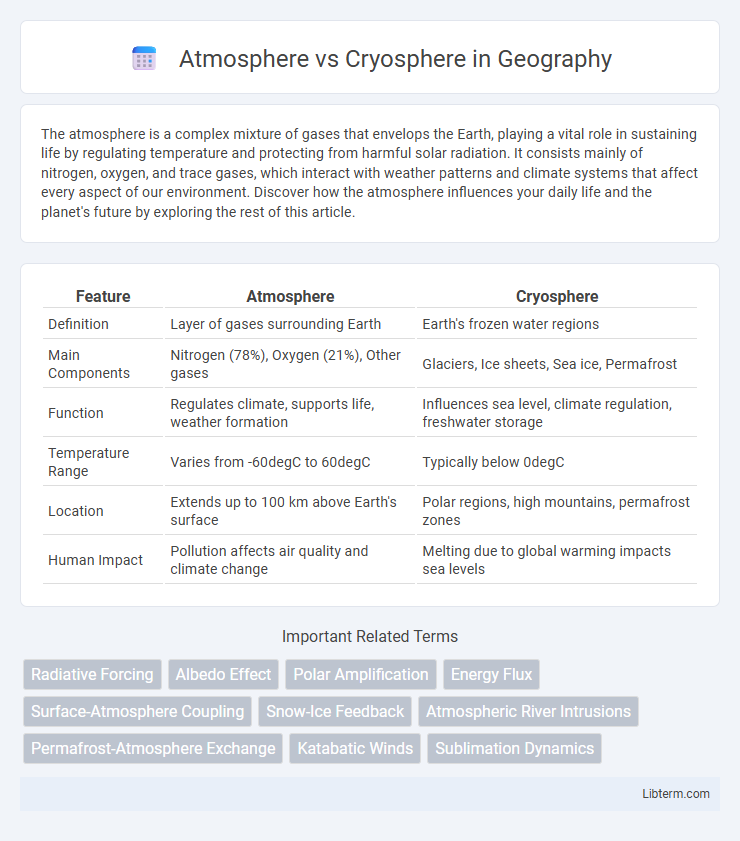The atmosphere is a complex mixture of gases that envelops the Earth, playing a vital role in sustaining life by regulating temperature and protecting from harmful solar radiation. It consists mainly of nitrogen, oxygen, and trace gases, which interact with weather patterns and climate systems that affect every aspect of our environment. Discover how the atmosphere influences your daily life and the planet's future by exploring the rest of this article.
Table of Comparison
| Feature | Atmosphere | Cryosphere |
|---|---|---|
| Definition | Layer of gases surrounding Earth | Earth's frozen water regions |
| Main Components | Nitrogen (78%), Oxygen (21%), Other gases | Glaciers, Ice sheets, Sea ice, Permafrost |
| Function | Regulates climate, supports life, weather formation | Influences sea level, climate regulation, freshwater storage |
| Temperature Range | Varies from -60degC to 60degC | Typically below 0degC |
| Location | Extends up to 100 km above Earth's surface | Polar regions, high mountains, permafrost zones |
| Human Impact | Pollution affects air quality and climate change | Melting due to global warming impacts sea levels |
Introduction to Atmosphere and Cryosphere
The atmosphere is the layer of gases surrounding Earth, composed primarily of nitrogen (78%) and oxygen (21%), playing a critical role in regulating temperature and weather patterns. The cryosphere includes all frozen water components on Earth, such as glaciers, ice caps, and sea ice, significantly impacting global climate by reflecting solar radiation. Interactions between the atmosphere and cryosphere influence climate systems, sea levels, and ecosystems worldwide.
Defining the Atmosphere
The atmosphere is a complex layer of gases surrounding Earth, primarily composed of nitrogen (78%) and oxygen (21%), essential for sustaining life and regulating climate. It consists of multiple layers, including the troposphere, stratosphere, mesosphere, thermosphere, and exosphere, each playing a critical role in weather patterns, radiation absorption, and temperature control. Unlike the cryosphere, which encompasses frozen water in glaciers, ice caps, and permafrost, the atmosphere is dynamic and gaseous, continuously interacting with Earth's surface and the cryosphere to influence global climate systems.
Understanding the Cryosphere
The cryosphere encompasses Earth's frozen water components, including glaciers, ice caps, sea ice, and permafrost, playing a crucial role in regulating global climate by reflecting solar radiation and storing vast amounts of freshwater. Unlike the atmosphere, which is the gaseous layer surrounding Earth and drives weather patterns, the cryosphere acts as a temperature buffer by influencing ocean circulation and moderating heat exchanges. Understanding the cryosphere's dynamics is essential for predicting climate change impacts, as its accelerated melting contributes to sea level rise and alters atmospheric conditions worldwide.
Components and Structure Comparison
The atmosphere consists of layered gases, primarily nitrogen (78%) and oxygen (21%), organized into the troposphere, stratosphere, mesosphere, thermosphere, and exosphere, each with distinct temperature gradients and pressure levels. The cryosphere encompasses all frozen water components, including glaciers, sea ice, snow cover, permafrost, and ice sheets, distributed mainly in polar and mountainous regions, affecting Earth's albedo and climate regulation. While the atmosphere is dynamic and fluid with rapid changes in weather patterns, the cryosphere is solid and evolves slowly, playing a critical role in long-term climate stability and freshwater storage.
Key Functions of the Atmosphere
The atmosphere regulates Earth's temperature by trapping heat through the greenhouse effect, enabling a stable climate essential for life. It facilitates the water cycle by transporting moisture, resulting in precipitation that sustains terrestrial and aquatic ecosystems. Furthermore, the atmosphere protects the planet from harmful solar radiation and meteor impacts, maintaining environmental conditions conducive to biodiversity.
Major Roles of the Cryosphere
The cryosphere plays a critical role in regulating Earth's climate by reflecting solar radiation through its high albedo, which helps maintain global temperature balance. It acts as a freshwater reservoir, storing vast amounts of ice and snow that influence sea level and global water cycles. The cryosphere also affects atmospheric circulation patterns by modulating thermal gradients and feedback mechanisms essential for weather and climate systems.
Interactions Between Atmosphere and Cryosphere
Interactions between the atmosphere and cryosphere significantly influence global climate regulation, with atmospheric temperature and humidity directly impacting ice sheet melting and snowpack accumulation. Variations in cryospheric elements such as sea ice extent and glacier mass balance alter surface albedo, modifying atmospheric heat absorption and circulation patterns. These dynamic feedback mechanisms contribute to changes in weather patterns, sea-level rise, and global temperature trends.
Impacts of Climate Change on Both Spheres
Climate change drives rising temperatures that disrupt the atmosphere by increasing greenhouse gases like CO2 and methane, intensifying weather extremes such as hurricanes and droughts. Simultaneously, the cryosphere faces accelerated ice melt in glaciers and polar ice caps, contributing to sea level rise and altering ocean circulation patterns. The interplay between atmospheric warming and cryospheric loss amplifies global climate feedback loops, exacerbating environmental instability worldwide.
Significance for Earth’s Climate System
The atmosphere regulates Earth's climate by controlling temperature, humidity, and weather patterns through the greenhouse effect and air circulation. The cryosphere, comprising glaciers, ice caps, and sea ice, influences global climate by reflecting solar radiation and storing vast amounts of freshwater. Interactions between the atmosphere and cryosphere are critical for climate feedback mechanisms and sea level regulation.
Future Research and Conservation Efforts
Future research on atmosphere and cryosphere interactions should prioritize understanding feedback mechanisms affecting global climate systems and polar ice dynamics. Conservation efforts must integrate advanced satellite monitoring and climate modeling to predict and mitigate the impacts of atmospheric changes on glacial melt and sea level rise. Collaboration between climate scientists, policymakers, and Indigenous communities is essential to develop adaptive strategies for preserving fragile cryospheric environments amid accelerating atmospheric warming.
Atmosphere Infographic

 libterm.com
libterm.com